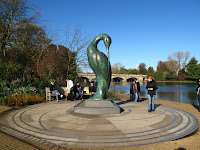

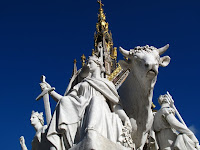
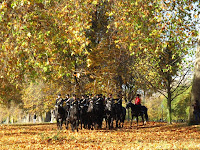
Murray & Christine's record of their journey. "A day in a car in an English county is a trip to a fairy museum where all the exhibits are live and real." Rudyard Kipling

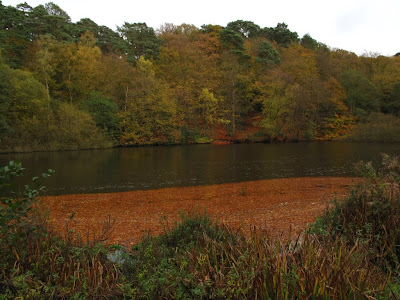
 The first indoor activity was Clandon House, home to the Onslow family. The interior (of the outwardly boring brick 'box') is quite sumptuous, with wonderful ceilings in every room. We found this house particularly interesting, as it was the home to New Zealand's 11th Governor General, his term starting in 1889. Only 34 years old at the start of his term, Lord Onslow was the first Governor General to have a baby born in New Zealand. This child was given a beautiful kiwi feather cloak, in which he was presented to the Maori elders.
The first indoor activity was Clandon House, home to the Onslow family. The interior (of the outwardly boring brick 'box') is quite sumptuous, with wonderful ceilings in every room. We found this house particularly interesting, as it was the home to New Zealand's 11th Governor General, his term starting in 1889. Only 34 years old at the start of his term, Lord Onslow was the first Governor General to have a baby born in New Zealand. This child was given a beautiful kiwi feather cloak, in which he was presented to the Maori elders.  The cloak on display, along with many artefacts of his time in New Zealand. But the most interesting 'souvenir' is a Maori meeting house in pride of place in the front garden. This particular house stood in the Te Wairoa village near Rotorua. When Mount Tarawera erupted, it was one of few buildings which survived, and saved many people's lives.
The cloak on display, along with many artefacts of his time in New Zealand. But the most interesting 'souvenir' is a Maori meeting house in pride of place in the front garden. This particular house stood in the Te Wairoa village near Rotorua. When Mount Tarawera erupted, it was one of few buildings which survived, and saved many people's lives.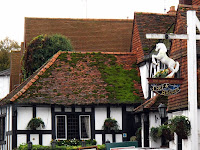 The town of Shere is nearby, and a very picturesque stop for a Sunday pub lunch. After a delicious shared platter and desert, we set off along country lanes covered in leaves, to Friday Street. This is a perfect autumn destination, with the golden trees reflected in the lake.
The town of Shere is nearby, and a very picturesque stop for a Sunday pub lunch. After a delicious shared platter and desert, we set off along country lanes covered in leaves, to Friday Street. This is a perfect autumn destination, with the golden trees reflected in the lake. Our route home took us through Brockham. This is a lovely village built around a large green, but the really interesting feature, was a huge bonfire stack, which appeared to be the work of the whole village. We were told that they used to build one twice the size, but current health and safety restrictions have limited it to what seemed to us an enormous and very well constructed pile of tree clippings and branches.
Our route home took us through Brockham. This is a lovely village built around a large green, but the really interesting feature, was a huge bonfire stack, which appeared to be the work of the whole village. We were told that they used to build one twice the size, but current health and safety restrictions have limited it to what seemed to us an enormous and very well constructed pile of tree clippings and branches. 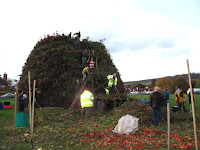 We were told that the bonfire would burn a week after it is lit next Saturday. We have seen signs in villages, before, advertising their bonfire night, but never actually witnessed a bonfire in construction before and certainly didn't realise what a spectacular sight it must be.
We were told that the bonfire would burn a week after it is lit next Saturday. We have seen signs in villages, before, advertising their bonfire night, but never actually witnessed a bonfire in construction before and certainly didn't realise what a spectacular sight it must be.


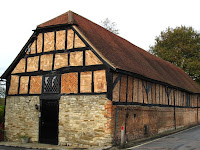

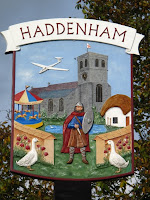 The tour continued to several 'hidden gems' - villages which were just off to the side of routes we have travelled often. Mentmore has a stunning 'Rotheschild mansion', not far from other ex Rotheschild homes we have visited in Buckinghamshire. But our favourite new discovery was Haddenham. This is a large sprawling village, and the more we explored, it seemed to have more and more narrow streets of lovely old houses, and several grass greens. The largest of these was in front of the church.
The tour continued to several 'hidden gems' - villages which were just off to the side of routes we have travelled often. Mentmore has a stunning 'Rotheschild mansion', not far from other ex Rotheschild homes we have visited in Buckinghamshire. But our favourite new discovery was Haddenham. This is a large sprawling village, and the more we explored, it seemed to have more and more narrow streets of lovely old houses, and several grass greens. The largest of these was in front of the church.
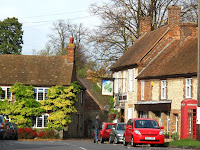


 The Whipsnade Tree Cathedral was planted after World War I by Edmund Blyth, to commemorate two fallen comrades. The concept is brilliant, and it looks great on paper but sadly, through the ravages of disease, many of the
The Whipsnade Tree Cathedral was planted after World War I by Edmund Blyth, to commemorate two fallen comrades. The concept is brilliant, and it looks great on paper but sadly, through the ravages of disease, many of the  original trees have also become 'fallen comrades' and their replacements are too young to look as magnificent as the name suggests.
original trees have also become 'fallen comrades' and their replacements are too young to look as magnificent as the name suggests. 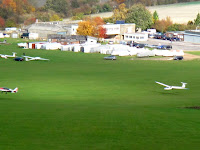 But despite that, we did a walk today to enjoy the autumn colours, that took in the Whipsnade Tree Cathedral.
But despite that, we did a walk today to enjoy the autumn colours, that took in the Whipsnade Tree Cathedral. From there, past a very picturesque (and also very closed due to the early hour we set out) pub, on a mostly level path back to the NT Centre.
From there, past a very picturesque (and also very closed due to the early hour we set out) pub, on a mostly level path back to the NT Centre. The autumn colours are definitely more advanced than last week, and most spectacular on our drive back via Aldbury.
The autumn colours are definitely more advanced than last week, and most spectacular on our drive back via Aldbury.
 Today we were in the area, and a grade 2 bore was due at 9am, 10 minutes from our hotel in Stonehouse. It was the perfect occasion to get the general idea of what the bore looks like, at a civilized time of day. We arrived in good time at 'Stonebench', one of the places recommended on the Severn Bore official website.
Today we were in the area, and a grade 2 bore was due at 9am, 10 minutes from our hotel in Stonehouse. It was the perfect occasion to get the general idea of what the bore looks like, at a civilized time of day. We arrived in good time at 'Stonebench', one of the places recommended on the Severn Bore official website.  Unfortunately, we learnt that their website is rather out of date in recommending this spot. It used to be good when a large underwater stone bench made the water jump at this point, but although this slab (the Stonebench) was removed some time ago, they haven't changed the website! Some helpful surfies who were waiting there to catch the wave, recommended we wait at
Unfortunately, we learnt that their website is rather out of date in recommending this spot. It used to be good when a large underwater stone bench made the water jump at this point, but although this slab (the Stonebench) was removed some time ago, they haven't changed the website! Some helpful surfies who were waiting there to catch the wave, recommended we wait at  Maisemore bridge. The website said it would pass through there at 9.19am, so we had time to get there. But 9.19 came and went, with no sign of a wave. Fortunately a local came down to show some visitors the Bore, and told us it was running 20 minutes late. It finally came through about 9.55am and was worth the wait.. A grade 4 Bore must be most impressive.
Maisemore bridge. The website said it would pass through there at 9.19am, so we had time to get there. But 9.19 came and went, with no sign of a wave. Fortunately a local came down to show some visitors the Bore, and told us it was running 20 minutes late. It finally came through about 9.55am and was worth the wait.. A grade 4 Bore must be most impressive.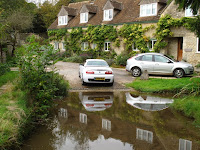 The highlights of these were a walk from Duntisbourne Abbots to Duntisbourne Leer. There are four villages along the Dunt stream, each village has a ford, which apart from the picturesque cottages, makes the villages especially appealing. The biggest town is Duntisbourne Abbots where started the walk, and the ford runs along the road between this village and Duntisbourne Leer for about 20m.
The highlights of these were a walk from Duntisbourne Abbots to Duntisbourne Leer. There are four villages along the Dunt stream, each village has a ford, which apart from the picturesque cottages, makes the villages especially appealing. The biggest town is Duntisbourne Abbots where started the walk, and the ford runs along the road between this village and Duntisbourne Leer for about 20m.  These days it is classed as unsuitable for vehicles, but in the days of horses and carts, it apparently cleaned the cart wheels. The route wound back to Cirencester, which we seem to have missed on any travels in the area. It is a stunning town, and a photographers delight. The stately home of Lord Bathurst, the local gentry, is surrounded by a hedge planted in 1720, and now claims to be the tallest yew hedge in Europe. Needless to say, there were no glimpses of the house.
These days it is classed as unsuitable for vehicles, but in the days of horses and carts, it apparently cleaned the cart wheels. The route wound back to Cirencester, which we seem to have missed on any travels in the area. It is a stunning town, and a photographers delight. The stately home of Lord Bathurst, the local gentry, is surrounded by a hedge planted in 1720, and now claims to be the tallest yew hedge in Europe. Needless to say, there were no glimpses of the house.
 leading from Cirencester, as it was second only in importance to London in Roman times. The Birdlip area has stunning hillsides covered in beech trees, now turning golden. We visited two of the viewpoints in the area, with views across to Wales.
leading from Cirencester, as it was second only in importance to London in Roman times. The Birdlip area has stunning hillsides covered in beech trees, now turning golden. We visited two of the viewpoints in the area, with views across to Wales.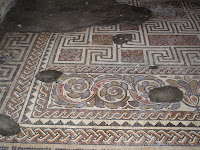 onsidering the importance of Cirencester in Roman times, it's not surprising that a number of Romans ruins have been discovered. We ended the day by visiting Chedworth Roman Villa. There are some partial mosaic tile floors and outlines of various rooms, with parts still visible of their underfloor heating and sophisticated bathrooms. The villa is interesting, but far more stunning is the beautiful drive there looking across at the golden beech clad hills.
onsidering the importance of Cirencester in Roman times, it's not surprising that a number of Romans ruins have been discovered. We ended the day by visiting Chedworth Roman Villa. There are some partial mosaic tile floors and outlines of various rooms, with parts still visible of their underfloor heating and sophisticated bathrooms. The villa is interesting, but far more stunning is the beautiful drive there looking across at the golden beech clad hills.




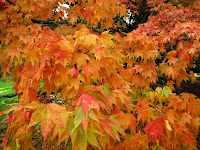


 Having flashed past Baden-Baden on our August, Black Forest, trip we felt it merited a weekend all to itself. A reasonably early start in London had us on the ground at Baden Airpark at 10 o'clock where,
Having flashed past Baden-Baden on our August, Black Forest, trip we felt it merited a weekend all to itself. A reasonably early start in London had us on the ground at Baden Airpark at 10 o'clock where,  due to slow processing at passport control, we just missed the bus to the city. Baden-Airpark is without doubt the worst serviced airport we have ever visited (well in excess of 100) in terms of public transport from the airport to the city; we had an hour to wait for the next bus and the one after that was further 90 minutes behind. Some consolation was that by the time we finally arrived at our Hotel in the centre, we were able to check in to our room immediately and rid ourselves of our backpacks.
due to slow processing at passport control, we just missed the bus to the city. Baden-Airpark is without doubt the worst serviced airport we have ever visited (well in excess of 100) in terms of public transport from the airport to the city; we had an hour to wait for the next bus and the one after that was further 90 minutes behind. Some consolation was that by the time we finally arrived at our Hotel in the centre, we were able to check in to our room immediately and rid ourselves of our backpacks.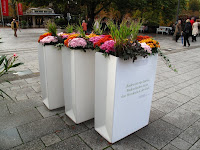 The Am Makt Hotel is worthy of a mention as the location is superb, right in the heart of the city and very close to the spas, the room was fabulous, the service is personal and the delicious breakfast is served by the owner.
The Am Makt Hotel is worthy of a mention as the location is superb, right in the heart of the city and very close to the spas, the room was fabulous, the service is personal and the delicious breakfast is served by the owner. The weather forecast for the weekend was not auspicious but the indications were that there would be a little sunshine later in the afternoon so we set off to enjoy one of Baden-Baden's indoor attractions while the rain fell outside. Baden-Baden's claim to fame came from the geothermal springs and it has been a spa town since Roman times.
The weather forecast for the weekend was not auspicious but the indications were that there would be a little sunshine later in the afternoon so we set off to enjoy one of Baden-Baden's indoor attractions while the rain fell outside. Baden-Baden's claim to fame came from the geothermal springs and it has been a spa town since Roman times.  The spa baths are now major tourist attractions the first one we visited was Caracalla Therme. This has extensive indoor and outdoor pools and an upstairs sauna area where we happily whiled away 3 hours getting alternately hot and cold or resting on the various beds.
The spa baths are now major tourist attractions the first one we visited was Caracalla Therme. This has extensive indoor and outdoor pools and an upstairs sauna area where we happily whiled away 3 hours getting alternately hot and cold or resting on the various beds. True to prediction the sun was out when we left the spa and so we explored the town centre and set off along the Lichtentaler Allee. This is a 1½ mile tree-lined lane that follows a stream up to the Lichtental Cloisters at the far end. The area was laid out as an “English” park back in the mid 1800s and is a most pleasant place to stroll, especially with the autumn colours beginning to show on the trees.
True to prediction the sun was out when we left the spa and so we explored the town centre and set off along the Lichtentaler Allee. This is a 1½ mile tree-lined lane that follows a stream up to the Lichtental Cloisters at the far end. The area was laid out as an “English” park back in the mid 1800s and is a most pleasant place to stroll, especially with the autumn colours beginning to show on the trees. Partway along the path there is a rose garden which, while past its best, still had plenty of blooms. It is an indication of Baden-Baden's mild climate that the roses were still blooming in October at the same time as the autumn colours.
Partway along the path there is a rose garden which, while past its best, still had plenty of blooms. It is an indication of Baden-Baden's mild climate that the roses were still blooming in October at the same time as the autumn colours. hidden away in a courtyard that we would never had found had we not been told it was there. This is also a family run concern and turned out to be a real treat. The menu items were fairly standard German fare but the specials board offered wonderful choices and the flat-bread, pizza-like apple dessert was most unusual and very scrummy. Washed down with a wonderful local Riesling it was a most memorable meal.
hidden away in a courtyard that we would never had found had we not been told it was there. This is also a family run concern and turned out to be a real treat. The menu items were fairly standard German fare but the specials board offered wonderful choices and the flat-bread, pizza-like apple dessert was most unusual and very scrummy. Washed down with a wonderful local Riesling it was a most memorable meal. Sunday started quite pleasant, so we attempted a walk from the town past the new castle to the old ruined castle on the hill above the town with the autumn colours making the walk very picturesque.
Sunday started quite pleasant, so we attempted a walk from the town past the new castle to the old ruined castle on the hill above the town with the autumn colours making the walk very picturesque. The process begins with a hot room and then an even hotter room after which is the scrub and massage. Then there are a series of pools getting cooler and cooler until the last on, an 18C plunge pool. After that is the cream room, where two different cream lotions soothe the super clean skin, before we were wrapped in a sheet and blanket, cocoon-style for a 30 minute rest. On a winter's day, this was the ideal way to rest and recuperate.
The process begins with a hot room and then an even hotter room after which is the scrub and massage. Then there are a series of pools getting cooler and cooler until the last on, an 18C plunge pool. After that is the cream room, where two different cream lotions soothe the super clean skin, before we were wrapped in a sheet and blanket, cocoon-style for a 30 minute rest. On a winter's day, this was the ideal way to rest and recuperate.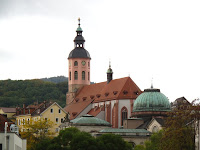 Although, now, completely toned and healthy, we felt compelled to give the locality one more chance after our August trip's failure to find a proper black forest gateau. This time we had asked our waitress on Saturday night for a recommendation, and so finally found the perfect Black Forest gateau at the Konig Cafe.
Although, now, completely toned and healthy, we felt compelled to give the locality one more chance after our August trip's failure to find a proper black forest gateau. This time we had asked our waitress on Saturday night for a recommendation, and so finally found the perfect Black Forest gateau at the Konig Cafe.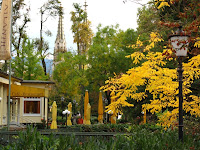 The guidebook said a skirt or dress was essential for women, and a tie and any type of jacket for men. But when we attempted to pay our entry fee, we discovered that 'any jacket' did not include a black leather bomber style jacket. This was dismissed as too “sporty”, and an offer was made to rent a jacket. But the real problem was we were required to show our passports which were safely stored in our hotel room. The rain was even harder, so we lost enthusiasm rapidly at that point, and will just have to imagine the grandeur inside.
The guidebook said a skirt or dress was essential for women, and a tie and any type of jacket for men. But when we attempted to pay our entry fee, we discovered that 'any jacket' did not include a black leather bomber style jacket. This was dismissed as too “sporty”, and an offer was made to rent a jacket. But the real problem was we were required to show our passports which were safely stored in our hotel room. The rain was even harder, so we lost enthusiasm rapidly at that point, and will just have to imagine the grandeur inside.
